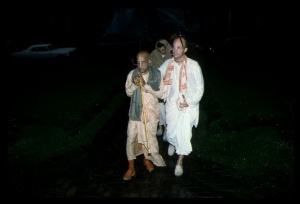CC Antya 14.14 (1975): Difference between revisions
(Vanibot #0027: CCMirror - Mirror CC's 1996 edition to form a basis for 1975) |
(Vanibot #0020: VersionCompareLinker - added a link to the Version Compare feature) |
||
| Line 2: | Line 2: | ||
<div style="float:left">'''[[Sri Caitanya-caritamrta (1975)|Śrī Caitanya-caritāmṛta (1975)]] - [[CC Antya (1975)|Antya-līlā]] - [[CC Antya 14 (1975)|Chapter 14: Lord Śrī Caitanya Mahāprabhu's Feelings of Separation from Kṛṣṇa]]'''</div> | <div style="float:left">'''[[Sri Caitanya-caritamrta (1975)|Śrī Caitanya-caritāmṛta (1975)]] - [[CC Antya (1975)|Antya-līlā]] - [[CC Antya 14 (1975)|Chapter 14: Lord Śrī Caitanya Mahāprabhu's Feelings of Separation from Kṛṣṇa]]'''</div> | ||
<div style="float:right">[[File:Go-previous.png|link=CC Antya 14.13 (1975)|Antya-līlā 14.13]] '''[[CC Antya 14.13 (1975)|Antya-līlā 14.13]] - [[CC Antya 14.15 (1975)|Antya-līlā 14.15]]''' [[File:Go-next.png|link=CC Antya 14.15 (1975)|Antya-līlā 14.15]]</div> | <div style="float:right">[[File:Go-previous.png|link=CC Antya 14.13 (1975)|Antya-līlā 14.13]] '''[[CC Antya 14.13 (1975)|Antya-līlā 14.13]] - [[CC Antya 14.15 (1975)|Antya-līlā 14.15]]''' [[File:Go-next.png|link=CC Antya 14.15 (1975)|Antya-līlā 14.15]]</div> | ||
{{CompareVersions|CC|Antya 14.14|CC 1975|CC 1996}} | |||
{{RandomImage}} | {{RandomImage}} | ||
==== TEXT 14 ==== | ==== TEXT 14 ==== | ||
<div class="verse"> | <div class="verse"> | ||
:rādhikāra bhāve prabhura sadā | :rādhikāra bhāve prabhura sadā 'abhimāna' | ||
:sei bhāve āpanāke haya | :sei bhāve āpanāke haya 'rādhā'-jñāna | ||
</div> | </div> | ||
| Line 25: | Line 24: | ||
<div class="translation"> | <div class="translation"> | ||
Śrīmatī Rādhārāṇī's emotions after seeing Uddhava exactly correspond to those of Śrī Caitanya Mahāprabhu. He always conceived of Himself in Her position and sometimes thought that He was Śrīmatī Rādhārāṇī Herself. | |||
</div> | </div> | ||
| Line 32: | Line 31: | ||
<div class="purport"> | <div class="purport"> | ||
Śrīla Bhaktisiddhānta Sarasvatī Ṭhākura explains that the purport of the word abhimāna, or | Śrīla Bhaktisiddhānta Sarasvatī Ṭhākura explains that the purport of the word abhimāna, or "self-conception," is that Śrī Caitanya Mahāprabhu thought Himself to be in the position of Śrīmatī Rādhārāṇī and was always ready to render service in that way. Although Śrī Caitanya Mahāprabhu is Kṛṣṇa Himself, He assumed the complexion and emotions of Śrīmatī Rādhārāṇī and remained in that status. He never assumed the complexion or status of Lord Kṛṣṇa. Of course, Kṛṣṇa wanted to experience the role of Śrīmatī Rādhārāṇī; that is the original cause of His assuming the body of Śrī Caitanya Mahāprabhu. Therefore pure Vaiṣṇavas never disturb Śrī Caitanya Mahāprabhu's conception of being Śrīmatī Rādhārāṇī. | ||
Unfortunately, at the present time a group of so-called devotees maintain that Śrī Caitanya Mahāprabhu is the enjoyer and that they are enjoyers as well. They have actually deviated from devotional service to the Lord. Śrī Caitanya Mahāprabhu manifested Himself to show that cultivation of love for Kṛṣṇa in separation is the easiest way of success for all living entities. Despite this fact, there are some theosophists who declare that because Śrī Caitanya Mahāprabhu is the Supreme Personality of Godhead, such cultivation is easy for Him but difficult for the living entity and that one can therefore approach Kṛṣṇa in any way he likes. To nullify this idea, Śrī Caitanya Mahāprabhu demonstrated practically how one can achieve love of Kṛṣṇa by adopting Śrīmatī | Unfortunately, at the present time a group of so-called devotees maintain that Śrī Caitanya Mahāprabhu is the enjoyer and that they are enjoyers as well. They have actually deviated from devotional service to the Lord. Śrī Caitanya Mahāprabhu manifested Himself to show that cultivation of love for Kṛṣṇa in separation is the easiest way of success for all living entities. Despite this fact, there are some theosophists who declare that because Śrī Caitanya Mahāprabhu is the Supreme Personality of Godhead, such cultivation is easy for Him but difficult for the living entity and that one can therefore approach Kṛṣṇa in any way he likes. To nullify this idea, Śrī Caitanya Mahāprabhu demonstrated practically how one can achieve love of Kṛṣṇa by adopting Śrīmatī Rādhārāṇī's mood in separation from Kṛṣṇa. | ||
</div> | </div> | ||
Latest revision as of 22:14, 26 January 2020

A.C. Bhaktivedanta Swami Prabhupada
TEXT 14
- rādhikāra bhāve prabhura sadā 'abhimāna'
- sei bhāve āpanāke haya 'rādhā'-jñāna
SYNONYMS
rādhikāra bhāve—in the emotion of Śrīmatī Rādhārāṇī; prabhura—of Śrī Caitanya Mahāprabhu; sadā—always; abhimāna—conception; sei bhāve—under such a conception; āpanāke—upon Himself; haya—becomes; rādhā-jñāna—consideration as Śrīmatī Rādhārāṇī.
TRANSLATION
Śrīmatī Rādhārāṇī's emotions after seeing Uddhava exactly correspond to those of Śrī Caitanya Mahāprabhu. He always conceived of Himself in Her position and sometimes thought that He was Śrīmatī Rādhārāṇī Herself.
PURPORT
Śrīla Bhaktisiddhānta Sarasvatī Ṭhākura explains that the purport of the word abhimāna, or "self-conception," is that Śrī Caitanya Mahāprabhu thought Himself to be in the position of Śrīmatī Rādhārāṇī and was always ready to render service in that way. Although Śrī Caitanya Mahāprabhu is Kṛṣṇa Himself, He assumed the complexion and emotions of Śrīmatī Rādhārāṇī and remained in that status. He never assumed the complexion or status of Lord Kṛṣṇa. Of course, Kṛṣṇa wanted to experience the role of Śrīmatī Rādhārāṇī; that is the original cause of His assuming the body of Śrī Caitanya Mahāprabhu. Therefore pure Vaiṣṇavas never disturb Śrī Caitanya Mahāprabhu's conception of being Śrīmatī Rādhārāṇī.
Unfortunately, at the present time a group of so-called devotees maintain that Śrī Caitanya Mahāprabhu is the enjoyer and that they are enjoyers as well. They have actually deviated from devotional service to the Lord. Śrī Caitanya Mahāprabhu manifested Himself to show that cultivation of love for Kṛṣṇa in separation is the easiest way of success for all living entities. Despite this fact, there are some theosophists who declare that because Śrī Caitanya Mahāprabhu is the Supreme Personality of Godhead, such cultivation is easy for Him but difficult for the living entity and that one can therefore approach Kṛṣṇa in any way he likes. To nullify this idea, Śrī Caitanya Mahāprabhu demonstrated practically how one can achieve love of Kṛṣṇa by adopting Śrīmatī Rādhārāṇī's mood in separation from Kṛṣṇa.